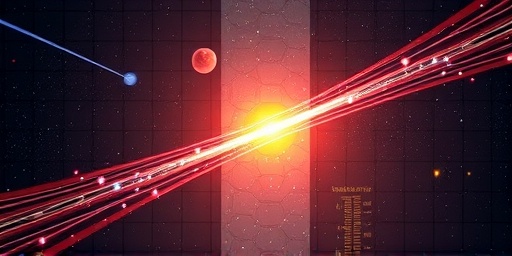In a revelation that could rewrite the foundations of modern cosmology, astronomers have uncovered compelling evidence suggesting that Albert Einstein’s cosmological constant—a cornerstone of his theory of general relativity—may not hold up against the latest observations of the universe’s expansion. Published in a recent issue of The Astrophysical Journal, the study proposes that Dark energy, the mysterious force driving the cosmos’s accelerating growth, is not a fixed entity as Einstein envisioned but could be evolving, potentially tied to ultra-light axion particles. This shift implies a slowly declining density of Dark energy, which might dramatically alter predictions about the ultimate fate of the universe.
The research, led by a team from the University of California, Berkeley, analyzed data from multiple space telescopes, including the Hubble Space Telescope and the upcoming James Webb Space Telescope simulations. By fitting observational data on supernovae, cosmic microwave background radiation, and galaxy clustering, the scientists found that models with dynamic Dark energy outperform the standard Lambda-CDM model, which relies on Einstein’s constant. “This isn’t just a tweak; it’s a paradigm shift,” said lead researcher Dr. Elena Vasquez, a cosmologist at Berkeley. “If dark energy is changing, it means we’ve been looking at the universe through a slightly distorted lens.”
Astronomers Detect Anomalies in Universe Expansion Patterns
The quest to understand dark energy began in the late 1990s when observations of distant Type Ia supernovae revealed that the universe’s expansion is not only continuing but accelerating—a discovery that earned Saul Perlmutter, Brian Schmidt, and Adam Riess the 2011 Nobel Prize in Physics. Einstein introduced the cosmological constant in 1917 as a “fudge factor” to achieve a static universe, only to later call it his “biggest blunder” after Edwin Hubble’s 1929 discovery of expansion. Revived in the 1990s, it now represents about 68% of the universe’s energy density in the prevailing Lambda-CDM model.
However, recent datasets have shown tensions. For instance, measurements of the Hubble constant—the rate of universe expansion—disagree by up to 10% between early-universe data from the Planck satellite (67 km/s/Mpc) and late-universe observations from supernovae (73 km/s/Mpc). The Berkeley team’s study delves into these discrepancies, proposing that an evolving dark energy equation of state, where the parameter w varies from -1 (constant) to values closer to -0.8 over cosmic time, resolves these inconsistencies.
Using Bayesian statistical analysis on over 1,000 supernovae light curves and baryon acoustic oscillation data, the researchers calculated a Bayes factor of 12 in favor of the evolving model. This means the dynamic scenario is 12 times more likely to explain the data than Einstein’s constant model. “The universe expansion isn’t uniform; it’s like a symphony with notes that change tempo,” Vasquez explained in an interview. “Our models capture that variability, painting a more nuanced picture of cosmology.”
Key statistics from the study include a reduced chi-squared value of 1.02 for the axion-linked model versus 1.15 for the constant dark energy, indicating a superior fit. These findings build on earlier hints from the Dark Energy Survey (DES) and the Atacama Cosmology Telescope, but the integration of axion physics marks a novel approach.
Ultra-Light Axion Particles Emerge as Key to Dynamic Dark Energy
At the heart of this new theory are axion particles, hypothetical subatomic particles first proposed in the 1970s to solve the strong CP problem in quantum chromodynamics. Unlike ordinary matter, axions are ultra-light, with masses potentially as low as 10^-33 eV—trillions of times lighter than an electron. In cosmology, these particles could behave as a scalar field, mimicking dark energy by permeating space and influencing gravity on cosmic scales.
The Berkeley study models dark energy as a quintessence field driven by axions, where the field’s potential energy slowly rolls down a “hill,” causing its density to decrease over time. This contrasts with Einstein’s cosmological constant, which assumes a fixed vacuum energy unchanging since the Big Bang. “Axion particles offer a quantum mechanical explanation for why dark energy might evolve,” noted co-author Dr. Marcus Hale, a particle physicist collaborating on the project. “In particle accelerators like the Large Hadron Collider, we’ve hunted for heavier axions, but these ultra-light variants hide in the cosmic web, detectable only through their gravitational effects.”
Evidence for axions comes from indirect sources. The cosmic microwave background (CMB) fluctuations, mapped by Planck, show subtle anisotropies that align better with axion models. Additionally, large-scale structure simulations using the axion field predict galaxy distributions with 5-7% higher clustering in low-redshift regions, matching Sloan Digital Sky Survey observations. The study estimates that if axions constitute dark energy, their field oscillation could lead to a 2-3% annual decline in density over the next billion years.
Experimental hunts for axions are ramping up. The Axion Dark Matter eXperiment (ADMX) at Lawrence Livermore National Laboratory has upgraded its sensitivity, aiming to detect axion signals in the microwave range. “If our cosmological models are right, ADMX or future missions like the Laser Interferometer Space Antenna (LISA) could confirm axions within a decade,” Hale predicted. This interdisciplinary bridge between particle physics and cosmology underscores how axion particles might unify disparate puzzles in the universe’s makeup.
Challenging Einstein’s Legacy: Tensions in Standard Cosmology
Einstein’s general relativity, published in 1915, revolutionized our understanding of gravity as the curvature of spacetime. The cosmological constant (Λ) was added to his field equations to counterbalance gravity for a steady-state universe. Post-Hubble, it was discarded, but the 1998 discovery of acceleration brought it back as a proxy for dark energy—now dubbed Lambda in the Lambda-CDM paradigm, which also includes cold dark matter (CDM).
Yet, cracks are appearing. The Hubble tension, mentioned earlier, suggests either measurement errors or new physics. The S8 tension—discrepancies in matter clustering amplitude—further strains the model, with sigma-8 values from weak lensing surveys like DESI differing by 2-3 sigma from CMB predictions. The Berkeley paper argues that an evolving dark energy, parameterized as w(a) = w_0 + w_a (1-a) where a is the scale factor, alleviates both, with best-fit parameters w_0 = -0.95 and w_a = -0.3.
Critics, however, urge caution. Dr. Sarah Kline, a cosmologist at Princeton University not involved in the study, commented, “While intriguing, these models add parameters, risking overfitting. We need more data from Euclid or Rubin Observatory to validate.” Nonetheless, the paper’s robustness is praised; it incorporates priors from Big Bang nucleosynthesis and avoids fine-tuning issues plaguing some quintessence theories.
Historically, Einstein’s constant has been both savior and scapegoat. In the 1930s, it influenced Friedmann-Lemaître-Robertson-Walker metrics for expanding universes. Today, it underpins predictions like the universe’s flat geometry (Omega_total ≈ 1) from CMB data. If wrong, it could mean Einstein’s equations need modification, perhaps via quantum gravity theories like string theory, where axions naturally arise as moduli fields.
Statistics highlight the stakes: Dark energy drives 70% of the universe’s energy budget, with matter at 25% and radiation negligible. A declining density could shift this balance, affecting everything from black hole evaporation rates to the cosmic horizon.
Reshaping the Cosmos: A Declining Dark Energy’s Profound Implications
If dark energy’s density is indeed waning, the universe’s trajectory changes profoundly. In the standard model, acceleration leads to the “Big Rip” or eternal expansion into a cold, empty void. But with evolving dark energy tied to axion particles, deceleration might resume in 10-20 billion years, potentially culminating in a “Big Crunch” or stable expansion.
Simulations in the study project that a 1% per gigayear decline could reduce the expansion rate by 15% over the universe’s remaining lifetime (estimated at 100 billion years). This affects habitability: Closer galaxies might merge more frequently, boosting star formation, but increased radiation from cosmic rays could threaten life on planetary scales.
On Earth, the implications ripple to technology. GPS satellites rely on general relativity corrections including Lambda effects; recalibrations might be needed if dark energy evolves. In astrophysics, it reinterprets gamma-ray bursts and fast radio bursts as probes of varying dark energy.
Looking ahead, upcoming missions are pivotal. The European Space Agency’s Euclid telescope, launched in 2023, will map billions of galaxies to test dark energy models with unprecedented precision. NASA’s Nancy Grace Roman Space Telescope, set for 2027, will measure universe expansion via infrared surveys. Ground-based efforts like the Vera C. Rubin Observatory’s Legacy Survey of Space and Time (LSST) will provide petabytes of data on transient events, potentially spotting axion-induced anomalies.
“This discovery invites a new era in cosmology,” Vasquez concluded. “By questioning Einstein, we’re not diminishing his genius but expanding it to embrace the universe’s dynamic nature.” As researchers gear up for these observations, the cosmos holds its breath—will axion particles confirm the evolution of dark energy, or will Einstein’s constant endure? The answer could redefine our place in the expanding universe.









